I'd have been pretty clueless about what to cook were it not for a chance introduction to the daughters of the US Ambassador to the Central African Republic. You see, I begin my research for a country's cuisine by searching online, but the Central African Republic certainly wasn't thinking of search-engine optimization when they chose their name, and it's super hard to find info that relates to the country and not to Central Africa generically. But thankfully, through my friend Oliver (sous chef for Cameroon!), I met the Wohlers daughters, and got first-hand advice on what to cook from those who know! This was really handy, because some of the food, like the mangoes and the avocado salad, aren't exactly the sort of things you find recipes for, but are the touches that make for a more representative meal.
We hosted a rare Saturday brunch because Laura and I rode the Five Boro Bike Tour the next day with an early wake-up time. For whatever reason — perhaps the country name that few have heard? — we didn't get many signups off our list, and it was a great opportunity to invite some last-minute guests. On hand were Jessica, Jill, Chrys, Al, Juliet, Barrak, and Kate.
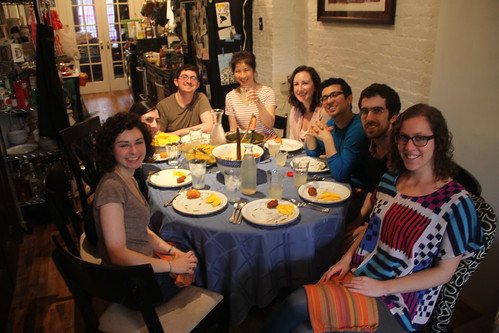
This was the first meal I made with my new African mortar and pestle. Not only does it have a fun design, but having this long-handled and heavy mortar and tall-sided and heavy-bottomed pestle is a big improvement over the wine-bottle-and-bowl method I've used for previous African meals!

Boisson au gingembre | Ginger drink | Recipe
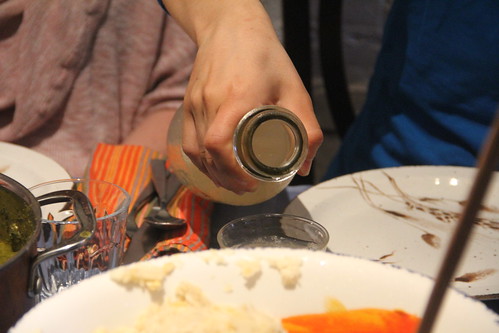
Most authentically I should have had palm wine, but I haven't seen it in any stores I've visited yet (but I hear rumors that there's a place in Fort Greene that sells it so I'll check that out soon.) I've heard ginger drinks are popular in Central Africa and it seemed fun to try, so hey. I went big on this recipe and interpreted "three or four big pieces of ginger" as one honkin' one pound hunk that I got for just $1 in Queens. Well, that, plus pennies' worth of sugar, cinnamon, cloves and lime juice made for a gallon of deliciously sharp refreshment. A good idea to keep it in something you can shake like jars with lids, because the yummy bits settle pretty quickly. It also mixes nicely with grapefruit juice; you could get adventurous with gin!
A note on technique: I pounded the ginger in the mortar and pestle before soaking it in boiling water; you could grate it or whiz it in the food processor, but both of those methods would release more juice and might make for a different flavor. Also, I didn't do the second hour's worth of soaking in a warm spot, I just added warm water from the tap and stuck it straight in the fridge.
Mangues | Mangoes
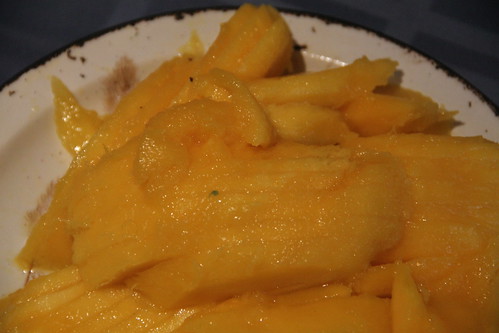
According to our source Sophie, who's spent considerable time in CAR, during mango season the fruits are abundant and free for the taking, and people eat so much of it that they poop orange. That's a pretty strong indication that we should be eating it too! I think finally, after nearly three decades on this planet, I've got a satisfactory mango-deconstructing technique: slice parallel to the flat side of the pit on both sides, use a big spoon to scoop out the mango from each side you've sliced off, slice those into thin slivers, and then hack at the pit to remove what you can. Though if you have advice, please share, since I know we'll be eating much more of this, the world's most popular fruit.
Ngoudja | Cassava leaves with beef and peanut butter | Recipe (in translation with a few of my notes)
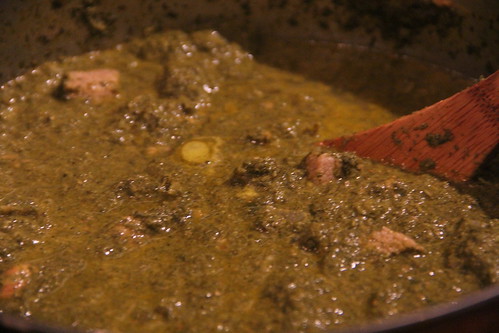
Yet another leaves-n-peanut stew! This recipe comes straight from an employee of the US Embassy in Bangui, and apparently this is a pretty representative dish, although the meat is probably a privilege. Cassava is an extremely common plant throughout the region, both the root and the leaves: it grows abundantly throughout the year, and between the leaves and the root it satisfies two major ingredient types. Mixed with peanut butter, it makes for an earthy, slightly bitter, and filling sauce. We also enjoyed it sprinkled with some Senegalese pepper flakes that were bigger on flavor than spice, and that I hope are a decent approximation of what might be found in CAR.
Foutou| Mashed yams and green plantains
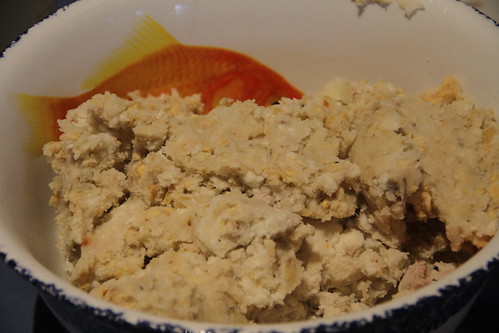
We had this sauce on top of yams and green plantains which I boiled and mashed, again in the mortar and pestle. Perhaps doing this with cassava, either boiled from whole or made into a fufu from powder, would have been a bit more representative, but we've had that so much recently that I wanted to shake it up. In the end, though, there's only so much variety: boiled, unseasoned starch is never going to be terribly exciting, although the texture of mashed-from-whole is a lot easier to get right then boiling and mixing the powder.
Linguistic note: the term foutou is one minor vowel modification away from a notorious swear word in French. It's as if mashed potatoes were named feck or something.
Salade d'avocats | Avocado salad
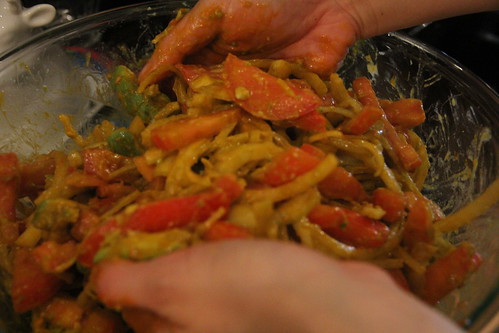
Sophie recounts that a very common salad in CAR is avocados, tomatoes, and onions, dressed with palm oil (and we added a bit of lemon juice too). Done! And tasty. I've now cooked plenty with palm oil but never eaten it raw, and wow, it lends a lot of flavor. The salad, which Barrak prepared and Chrys mixed up, was surprisingly rich and tasty.
Macara ti fôndô | Banana beignets | Recipe (translated to English)
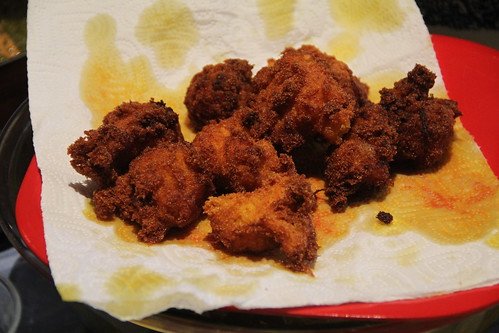
After the Cameroon frying fiasco, I was anticipating a break, but Sophie insisted that these "beignets are sold everywhere, and people love them." Twist my arm! Out came the deep fryer, with a mix of palm and corn oils — latter to save our unaccustomed Western guts from the full onslaught of the, uh, richness of the palm oil. It took a bit of experimenting with the batter recipe. I used plantains since I figure that's what they mean by bananas in that part of the world, but either one would probably be fine. The 100 grams of semolina was not enough to absorb the liquid and made for a very goopy batter that didn't hold together when frying. With perhaps double the amount of semolina, it made for fantastic fritters: a crispy outside redolent with luscious palm oil, and a soft and sweet inside with the lovely flavor of banana and a hint of the nuttiness of semolina.
Thanks to the generosity of our guests, we were able to contribute over $160 for the World Food Program USA this week. The WFP is active in Central African Republic, with plans to serve over 320,000 people there this year.

Big thanks again to the Wohlers sisters, especially Sophie, for the help in figuring out what to cook! Next week we head one country to the north to Chad, where we'll wrap up our string of six African countries in an eight-country stretch. I'll be trying my hand at millet beer, let's see how it goes!
